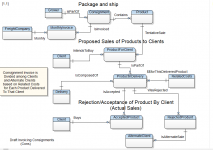The project i am working on is to migrate the company business from a excel spreadsheet into an access database to improve data quality, data consistency and improve the multi user experience as there are now 4 people continuously updating and using 1 HUGE excel spreadsheet which is creaking under the weight of this.
As it is we have consignments, deliveries, products and invoice information relating to delivered products as follows:
A Consignment
Made up of products coming by air or ship to a warehouse at dock/airport
Consignment Deliveries
A consignment can be broken up into 1 or many deliveries to a client
Delivered Products
A delivery can be made up of 1 or many products that are part of the consignment
Multiple invoices can be sent to the company based around all manner of actions carried out for the final product delivery, things like transport, customs clearance, packing etc.
Invoices will be supplied with a total amount and then be split across multiple deliveries which potentially could be across multiple consignments.
I need to log specific amounts that relate to a delivered product and attach that to a main invoice summary and total amount.
Currently I have a form which allows the user to filter the consignments to highlight specific ones that an invoice will relate to, select them and then generate an invoice summary record and then entries into a bridging table linking the invoice summary record to all the relevant consignments:

The user can then bring up a second form which will allow them to allocate the total amount across the delivered products, using the bridging table and the PK/FK links between consignments, deliveries and delivered products and filtering the delivered data and select specific delivered lines to allocate the specific amounts to:

So what i want to happen is:
My thought is that i need a 3rd table that has:
thanks in advance
Glen
As it is we have consignments, deliveries, products and invoice information relating to delivered products as follows:
A Consignment
Made up of products coming by air or ship to a warehouse at dock/airport
Consignment Deliveries
A consignment can be broken up into 1 or many deliveries to a client
Delivered Products
A delivery can be made up of 1 or many products that are part of the consignment
Multiple invoices can be sent to the company based around all manner of actions carried out for the final product delivery, things like transport, customs clearance, packing etc.
Invoices will be supplied with a total amount and then be split across multiple deliveries which potentially could be across multiple consignments.
I need to log specific amounts that relate to a delivered product and attach that to a main invoice summary and total amount.
Currently I have a form which allows the user to filter the consignments to highlight specific ones that an invoice will relate to, select them and then generate an invoice summary record and then entries into a bridging table linking the invoice summary record to all the relevant consignments:
The user can then bring up a second form which will allow them to allocate the total amount across the delivered products, using the bridging table and the PK/FK links between consignments, deliveries and delivered products and filtering the delivered data and select specific delivered lines to allocate the specific amounts to:
So what i want to happen is:
- The user can enter values in the invoice amount for any delivery line they want to, but the amount can not exceed the total amount for the invoice.
- If the user comes back to the invoice it shows all relevant deliveries whether they have amounts or not and shows the amounts for the deliveries the user has added the amounts to
- A delivery can belong to multiple invoices and each invoice it links to will have different invoiceable amounts
My thought is that i need a 3rd table that has:
- PK - autonumber
- FK - invoice ID
- FK - consignment ID
- FK - delivery ID
- FK - delivered product ID
- Total Amount
- The second form shows a place to enter an amount but no record is written to the 3rd table unless there is an amount
- Amounts written will be shown and be editable when you select an invoice
thanks in advance
Glen

